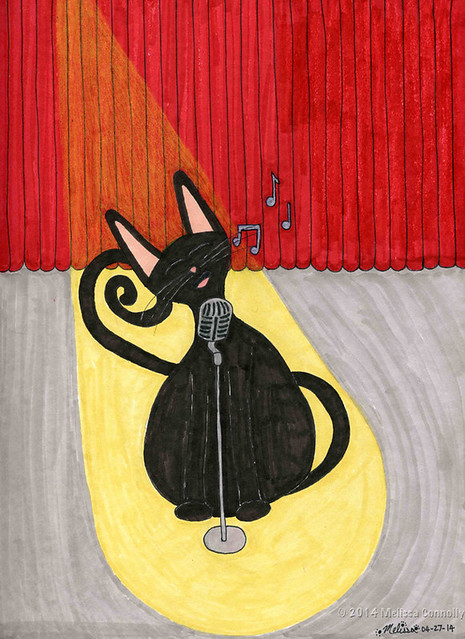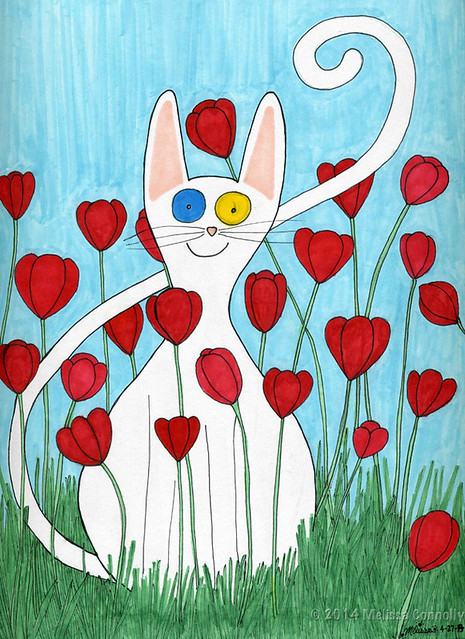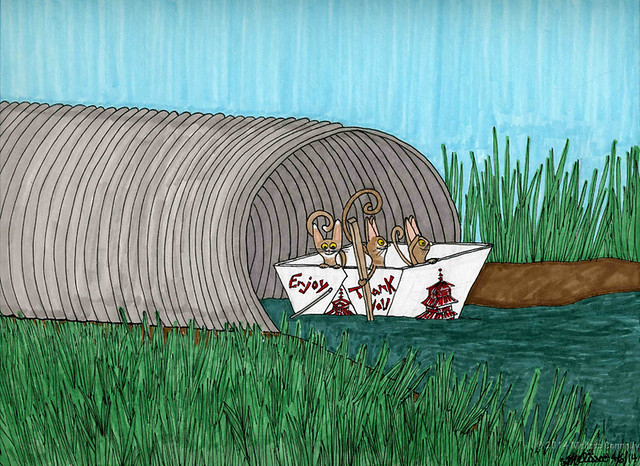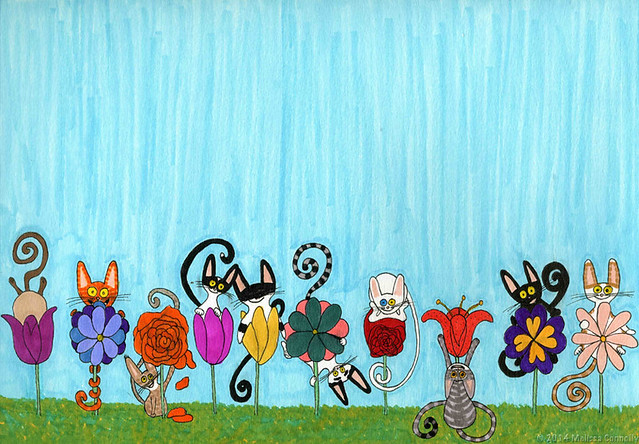[What is Johnny Kitties? See Johnny Kitties: Celebrating Johnny Depp for all the details.]
The film, ultimately, is a celebration of Hunter and his language and his discovery of his voice. It's before Hunter became Dr. Hunter S. Thompson. I think he'd be very proud. – Johnny Depp on The Rum Diary
This one's for Hunter.
The Rum Diary, which is based on Hunter S. Thompson's only novel, follows Paul Kemp (Johnny Depp), a young American journalist who is in San Juan, Puerto Rico, having accepted a position at the local newspaper, the San Juan Star, for which he is assigned to write the horoscopes and report on the bowling alley beat. New in town, and with lots of drinks and other questionable substances on the side, Paul observes the locals, from the privileged and untouchable, like expatriate Sanderson (Aaron Eckhart), to the struggling anonymous and poverty-stricken. With the help of his newspaper comrades, Sala (Michael Rispoli) and Moberg (Giovanni Ribisi), Paul uncovers the darker side of Sanderson's wealth and finds purpose and direction for his career. A project close to Johnny's heart,
The Rum Diary pays tribute and fulfills a promise made to his friend, offering a rare glimpse into Hunter Thompson's world before he became the great doctor of Gonzo journalism.
It was the start of something good.
 |
With Hunter Thompson
in the '90s |
Johnny was thrilled to meet Hunter S. Thompson, one of his favorite writers, in the '90s when he was slated to play the author's alter ego in Terry Gilliam's
Fear and Loathing in Las Vegas. To prepare for the role, Johnny lived in the writer's basement on Owl Creek Farm for a few months, absorbing like a sponge everything he could about the man. The two discovered that they had plenty in common, from their Southern roots and habit of questioning everything to their love of language and books. "Hunter was, prior to even meeting him, he was somebody that I greatly admired–his whole way of life, his whole sort of way of moving forward in this kind of strange little soup bowl of existence," Johnny explains. "When I met him, there was an instant click between the two of us. From that second on, it never let up. We were very close until the moment of his exit." It was while researching for
Fear and Loathing in Las Vegas that Johnny discovered The Rum Diary manuscript, written in 1959, stored in an old box in the basement. When they dusted it off, the writer wanted to turn it into a movie immediately. The actor suggested getting the story published first.

After The Rum Diary was published, Hunter Thompson and Johnny held informal meetings together with potential film producers and other contributors who could help get the movie made. "I had no idea what the hell to believe because Depp was charming and unfailingly polite, and then there was some dude with a camera. And, there was the great Hunter Thompson, and you absolutely could not understand a word that came out of his mouth," Producer Holly Sorenson remembers. "Just seeing their relationship, it was just very sweet. It was a very pure thing. It wasn't a business arrangement. It wasn't someone trying to do someone's book. They had real love between the two of them. I think that was obviously, as an observer, very seductive. Even if I didn't know how this book was going to turn into a movie, we had to try."
 |
| With Bruce Robinson on The Rum Diary set |
They chose Bruce Robinson to write and direct the film. Best known for creating the cult classic
Withnail and I, one of Johnny's favorite movies, Bruce Robinson hadn't made a movie in more than 20 years. Johnny worked his magic to lure him out of retirement for
The Rum Diary. "Adapting the book, you have to absorb what the book is, throw it away, and then rewrite it," Bruce Robinson says. "Hopefully, we did the vernacular of Hunter but not copy what he's written." He and Johnny scouted locations in Puerto Rico for the movie, and during one trip, their little plane stopped running mid-air. Just before panic struck, the engine perked up again. They both cracked up laughing and didn't talk about what happened until they were safely on the ground. I think the bond between these two goes well beyond mutual admiration.
 |
| Hunter Thompson's big exit |
Then something awful happened.
Hunter Thompson committed suicide in February 2005. Per his wishes, Johnny contracted the construction of a Gonzo monument (featuring the Gonzo double fist) to hold a cannon, from which the writer's ashes would blast out and over his farm. "All I'm doing is trying to make sure his last wish comes true," Johnny says of the plans. "I want to send my pal out the way he wants to go out." The private ceremony was a moving, celebratory one attended by Hunter Thompson's close friends and family, with readings of his work, his favorite music playing, and plenty of fireworks. From a height of 153 feet, the cannon sent him off in Hunter style.
The show must go on.
"The idea of The Rum Diary as a film was something that was cooked up between Hunter and myself," Johnny says. "One of my last efforts to salute the man was to continue on in our venture and force him, even in death, to be a producer. We just wanted Hunter there, and he was there every day, every second, every moment." Johnny had a producer's chair made with Hunter Thompson's name on it, which was placed on set every day. The chair held a script cover and was paired with a glass of whiskey, which the cast ritualistically dipped their fingers into like holy water at the start of each day's work. "Everyone chose to do this movie because of Johnny, because of the material," Executive Producer Patrick McCormick says. "Of all the Hunter Thompson projects that he might consider, this would be the most critical one, and there was never a question that this movie was going to get made one way or another. It just allows you to keep pushing forward with great confidence, no matter what the obstacles are."
It only took nearly 15 years.
Before the movie came out, I read The Rum Diary and really liked the story. I was excited to see the movie but disappointed by the previews. I felt they were marketing it as
Fear and Loathing in Las Vegas, Part 2, which I hoped would not be the case.
I was happy to discover that the few minutes of mayhem shown in these commercials do not represent all that happens in this movie. Despite its suggestive title,
The Rum Diary shows a calmer, quieter side of Hunter Thompson. While this story is fictional, Hunter Thompson did freelance in Puerto Rico, reporting on horoscopes and bowling alleys for that paper. "Looking back, I wasn't aware then what a special place it was or a special time," he said. It's difficult to watch this movie and not hear Hunter Thompson's voice and make the connection between fiction and history. The crew used the writer's books and photographs to capture that place and time as authentically as they could. Even the cameras lean toward a documentary-style point of view. "My approach was to be so minimalistic," Director of Photography Dariusz Wolski says. "The camera doesn't exist. It's an observer of what the story's about."

One of the best parts of this movie is recognizing the parallels between Hunter Thompson's and Paul Kemp's journeys and the authenticity that the crew created to honor them. While all the drinking and Giovanni Ribisi's over-the-top performance as the incessantly drunk Moberg are a bit much for me at times, I love the feel of this movie. With Bruce Robinson's great script and atmospheric direction, you experience Paul Kemp's time in Puerto Rico. "The thing that I connected with with Hunter's work was his brutal honesty and imagination," Johnny says. "When you read about these amazing experiences, you think, 'That's fake. He wrote that. That's his imagination.' But when you really spend time with him, which I have, you realize it's all true." Antics aside, I love
The Rum Diary's portrayal of Paul Kemp's struggle to discover the writer he wants to be. By the end of the movie, I feel a sweet sense of nostalgia for a time I'd never experienced and satisfaction in knowing that Hunter Thompson is on his way to becoming the writer we all know.
From what I could tell, critics were mixed about
The Rum Diary. You either loved it because you love Hunter Thompson, Bruce Robinson, or Johnny Depp, or you didn't get it and were annoyed by it. I witnessed the latter for myself: After seeing
The Rum Diary in the theater, I shuffled toward the exit behind two older ladies and heard one complain to the other about the movie's lack of eye candy. (Yes, she actually used the words "eye candy.") With the drunkenness, drugs, and cock fighting, I see her point. I, too, wished for more of the love story between Paul and Chanault (Amber Heard). I liked that storyline best in the book, but there are only two hours to work with for a movie.
I came out of the theater feeling better than those ladies did about
The Rum Diary. I'm not sure if the ordinary moviegoer–who didn't know all the blood, sweat, and tears that went into making this movie or who isn't a fan of Hunter Thompson–will fully appreciate
The Rum Diary for what it is. I agreed fully with what Ignaty Vishnevetsky said about it on Roger Ebert's At the Movies: "Bruce Robinson writes rich, punchy dialogue and really knows how to direct actors and create a subtle hungover atmosphere. This very funny, keenly observed movie meanders in the best way possible, moving from one misadventure to another while constantly developing its many eccentric characters." With this movie, you're just along for the ride.
Shooting on location was essential to achieving that feeling. "With the brilliance of these set designers, we could've built it all in the studio, but it wouldn't have had that intense heat. It wouldn't have had the smell of rot coming through the floor," Bruce Robinson explains. "It was impossible not to be there emotionally, physically, and in every way, and if we'd been on an air-conditioned sound stage, it wouldn't have been the same narrative."
I think
The Rum Diary turned out just as Hunter Thompson would have wanted it. From the spontaneous idea between two friends in a basement to the polished finished product in theaters, he created an unforgettable experience for everyone involved. "This is really something that's come from the heart for everybody," Actor Giovanni Ribisi says. "It's really rare when something like this happens."
The Kitties advise not to do this at home.
Despite my aversion to excessive drug and alcohol use, I love those scenes in
The Rum Diary. I credit the brilliance of the director and actors for putting me under the influence. One of my favorite scenes is after Paul (Gordon) and Sala (B.J.) acquire and use some potent eye drops from Moberg. They sit in their stuffy apartment, waiting for something to happen. When something does happen, it terrifies them both so much that they have to get out. They try to calm down during a nighttime walk with some rum in hand.
![43. The Rum Diary (2011) [January 15, 2014]](https://farm4.staticflickr.com/3783/13731534414_712897cd1e_z.jpg)
But the walk is not calming; it's frantic and without direction. As Sala walks straight on methodically, Paul appears behind him. Walking a faster pace, he crossing diagonally right to left and out of the shot. When Paul reappears by Sala's side, he snatches the rum bottle from Sala's hand and takes a swig without losing sight of whatever they're both seeing in the distance. The performances in this sequence are pretty priceless. Johnny's really good at playing a drugged up drunk guy.
I also love Puerto Rico's murky nighttime atmosphere in this scene: the solitude of the empty street and quiet sounds of the surrounding sea are completely different from the colorful vibrancy Puerto Rico emanates in daylight.
Johnny honors Hunter Thompson here too.
Aside from
The Rum Diary and
Fear and Loathing in Las Vegas, Johnny's adoration of Hunter Thompson comes through in several other projects. Among them are:
- Breakfast with Hunter. Johnny shows up in Wayne Ewing's 2003 documentary about Hunter Thompson, which gives a glimpse of the every-day life of the man behind the larger-than-life persona.
- When I Die. Wayne Ewing's 2005 documentary shows how the Gonzo monument was constructed for Hunter Thompson's one-of-a-kind sendoff. While Johnny is mentioned a few times in this documentary because he's overseeing the task, he's not actually in it. But it's interesting to watch this massive 153-foot structure being built so meticulously.
- Rolling Stone. After Hunter Thompson's death, Rolling Stone ran a tribute issue (March 24, 2005), for which Johnny wrote a wonderful essay called "A Pair of Deviant Bookends." You can read it here.

- Gonzo: The Life of Hunter S. Thompson. In 2006, Johnny penned another touching tribute, an introduction for this book by Jann Werner and Corey Seymour. You can read it here.
- Gonzo: The Life and Work of Hunter S. Thompson. Alex Gibney's 2008 documentary exposes Hunter Thompson in his element, mainly focusing on a 10-year period, 1965 to 1975. Johnny lends his voice here, reading passages from the writer's work.
- Gonzo: The Life and Work of Hunter S. Thompson–Music from the Film. This collection includes music and recordings of Johnny's readings from the documentary. Johnny also wrote the extensive liner notes for this CD with his friend, author Douglas Brinkley. They did such a good job that they were nominated for a Grammy! (Do you think Johnny was as excited about that as I was?)
What's next?
Johnny rises from the dead and tries to adapt to living in the '70s with his dysfunctional descendants in
Dark Shadows.
Copyright credits: All images from The Rum Diary © Film District and GK Films; Johnny Depp and Hunter Thompson candid © Kevin Mazur/Wire Images; Breakfast with Hunter DVD image © Wayne Ewing Films, Inc. and Gonzo International; Gonzo CD jacket image: Ralph Steadman; Johnny Kitties illustration: Melissa Connolly.


















![43. The Rum Diary (2011) [January 15, 2014]](https://farm4.staticflickr.com/3783/13731534414_712897cd1e_z.jpg)



